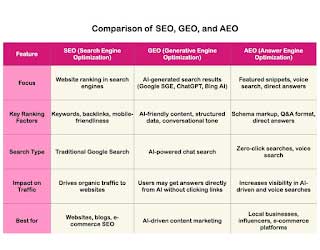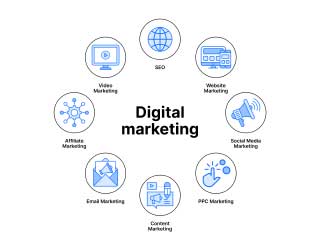The Future of SEO in 2025: Why Your Digital Strategy Needs to Evolve

As we move into 2025, the digital landscape continues to evolve at a rapid pace. For businesses, search engine optimization (SEO) has always been a crucial component of online success. However, the SEO strategies that worked a few years ago are no longer enough to stay competitive. With new technologies, user behavior changes, and continuous algorithm updates, SEO in 2025 requires a fresh approach to stay ahead of the curve.
In this blog, we’ll explore the SEO trends, strategies, and best practices businesses should follow in 2025 to ensure they’re not left behind.
Why SEO Still Matters in 2025
Even though the world of digital marketing is constantly shifting, SEO remains a key pillar in driving organic traffic to your website. While paid advertising can give you quick results, SEO provides long-term value, higher credibility, and better user engagement.
According to Host4Asia’s report on digital growth, over 70% of web traffic still comes from search engines, with Google leading the way. As a result, businesses that fail to prioritize SEO are likely to miss out on significant opportunities to connect with potential customers.
Top SEO Trends to Watch in 2025
As we head into 2025, here are the top SEO trends businesses should incorporate into their digital strategies:
1. AI and Machine Learning in SEO
Artificial Intelligence (AI) and machine learning are rapidly transforming SEO strategies. Google’s BERT and MUM algorithms, which have advanced natural language processing capabilities, are now able to understand the context and intent behind search queries. This means keywords alone won’t be enough to rank your pages.
Instead, Google is prioritizing content relevance and user intent. It’s no longer about matching the exact search query; it’s about understanding the topic in-depth and providing the best possible answer.
To stay ahead of the curve, businesses should focus on creating high-quality, comprehensive, and well-researched content that satisfies the user’s search intent.
2. Voice Search Optimization
With the rise of voice assistants like Siri, Alexa, and Google Assistant, optimizing your content for voice search has become increasingly important. By 2025, voice search is expected to account for over 50% of all search queries.
Voice search typically involves long-tail keywords and conversational phrases, so it’s essential to adapt your content to match how people speak rather than how they type.
3. Core Web Vitals and User Experience (UX)
Google’s Core Web Vitals (LCP, FID, and CLS) have been a key ranking factor for a while now, and they’ll continue to play an even more significant role in 2025. These metrics measure how quickly your page loads, how interactive it is, and how stable the content is during loading.
A website that provides an excellent user experience—with fast loading times, mobile-friendly design, and intuitive navigation—will rank higher than one that’s slow or clunky.
Ensure your website:
-
Has fast loading speeds (under 3 seconds).
-
Works seamlessly across all devices (especially mobile).
-
Provides clear calls to action and easy navigation.
4. The Rise of Video Content
Video continues to dominate online content consumption. By 2025, it’s estimated that 80% of all internet traffic will come from video. Not only do videos improve engagement, but they can also enhance your SEO efforts.
YouTube SEO will remain critical, but it’s also important to integrate video into your website. Whether it’s product demos, customer testimonials, or educational content, embedding video on your pages can increase dwell time, decrease bounce rates, and boost rankings.
5. Mobile-First Indexing
As more users shift to mobile devices for browsing, Google has prioritized mobile-first indexing, which means it predominantly uses the mobile version of a site for ranking and indexing.
A responsive website is no longer optional—it’s essential for ranking well in search results. Your website should look and perform well on mobile devices to meet the demands of both users and search engines.
6. Local SEO and Personalization
For businesses with a physical presence, local SEO will continue to be important in 2025. Optimizing your website for Google My Business, building local citations, and collecting positive reviews can help you rank in local search results.
In addition, personalized search results are becoming more common. Google uses user data and behavior to tailor search results, so businesses need to optimize their content for local and personalized searches to stay relevant.
How to Build an Effective SEO Strategy in 2025
To remain competitive in 2025, your SEO strategy needs to adapt to these new trends and technologies. Here’s how you can get started:
1. Focus on Content That Solves Problems
Your content should aim to solve problems for your target audience. Think about what questions your potential customers have and create detailed, valuable content that addresses those questions comprehensively. This approach will align with Google’s emphasis on user intent and content quality.
2. Use Structured Data (Schema Markup)
Implementing structured data (schema markup) helps search engines understand the context of your content. Rich snippets, knowledge graphs, and other forms of enhanced search results can increase your visibility and CTR (click-through rates).
3. Optimize for Featured Snippets
Featured snippets are becoming increasingly prominent in search results. These are the boxed-out answers that appear at the top of some search queries. To rank for these, focus on answering specific questions in your content and using proper formatting (bullet points, numbered lists, etc.).
4. Build High-Quality Backlinks
Backlinks remain one of the most important ranking factors. However, in 2025, the focus is on quality over quantity. Aim to build backlinks from authoritative, relevant websites in your industry to improve your website’s credibility and trustworthiness.
5. Invest in AI-Powered SEO Tools
As AI continues to shape SEO, utilizing AI-powered tools for content creation, keyword research, and SEO analysis will become essential. These tools can help you generate data-driven insights, automate tedious tasks, and stay ahead of SEO trends.
Conclusion
SEO in 2025 is more dynamic and competitive than ever before. Businesses must focus on providing high-quality content, optimizing for user experience, and embracing new technologies like AI and voice search to stay relevant.
With the right strategies in place, you can ensure that your website ranks high in search results, drives organic traffic, and ultimately contributes to the growth of your business.
At Host4Asia, we believe in helping businesses stay ahead of the digital curve. If you’re looking to optimize your website’s SEO strategy for 2025, we’re here to guide you every step of the way.
#SEO2025 #DigitalMarketing #ContentMarketing #VoiceSearch #MobileSEO #AIinSEO #CoreWebVitals #VideoSEO #LocalSEO #Host4Asia
visit: www.host4asia.com
Ashmita Chatkara
8750437842

In the ever-evolving digital landscape, businesses must stay ahead by optimizing their online presence. While SEO (Search Engine Optimization) has been a cornerstone of digital marketing for years, newer strategies like AEO (Answer Engine Optimization) and GEO (Generative Engine Optimization) are reshaping the way companies reach audiences.
In this blog, we break down what SEO, AEO, and GEO mean, how they’re used in the tech field, and how each can contribute to your business growth.
What is SEO?
SEO (Search Engine Optimization) refers to the process of optimizing your website and content to rank higher in traditional search engines like Google and Bing.
Key Components of SEO:
-
On-Page SEO: Keyword optimization, meta tags, URL structure, content quality
-
Off-Page SEO: Backlinks, social sharing, authority building
-
Technical SEO: Site speed, mobile-friendliness, structured data, crawlability
Use in Tech Field:
In the tech industry, SEO is essential for increasing organic traffic to software products, SaaS platforms, IT service pages, and developer documentation. A well-optimized site ensures discoverability among competitors.
Business Benefits:
-
Higher search visibility and brand awareness
-
Long-term cost-effective traffic generation
-
Trust and credibility from top-ranking positions
What is AEO?
AEO (Answer Engine Optimization) focuses on optimizing content for answer engines like Google’s featured snippets, voice assistants (Siri, Alexa), and AI-powered search platforms like ChatGPT.
Key Components of AEO:
-
Use of structured data (Schema.org)
-
Clear, concise answers to user questions
-
Question-based headings and bullet points
-
Strong FAQ content
Use in Tech Field:
Tech companies can use AEO to position their content for voice searches and AI snippets. For example, an IT support site might optimize for queries like “How to configure a Linux server?” so it appears directly in AI responses or voice searches.
Business Benefits:
-
Featured placements (position zero) on search results
-
Better visibility on voice and AI-based queries
-
Increased authority as an industry expert
-
Faster customer conversions due to instant answers
What is GEO?
GEO (Generative Engine Optimization) is a newer concept that focuses on optimizing content for generative AI platforms like ChatGPT, Gemini (Google), and Perplexity AI, which generate responses rather than showing traditional search results.
Key Components of GEO:
-
Providing structured, verifiable, and high-quality content
-
Authoritative sources and citations
-
Context-rich and detailed articles
-
AI-friendly formatting (clean headers, semantic HTML)
Use in Tech Field:
As users increasingly rely on AI assistants to make decisions, tech companies must create content that is favored and cited by these AI engines. GEO helps tech brands show up in AI responses when users ask for product comparisons, tutorials, or vendor recommendations.
Business Benefits:
-
Higher inclusion in AI-generated answers
-
Increased brand mentions and citations in AI tools
-
Competitive edge in AI-driven discovery
-
Future-proofing digital visibility as search habits evolve
Combining all three—SEO, AEO, and GEO—creates a powerful digital strategy that ensures your business is visible whether a user is searching, asking, or generating.
Final Thoughts
The digital world is no longer just about being “searchable”—it’s about being answerable and generatable. By embracing SEO, AEO, and GEO, businesses, especially in the tech sector, can maximize their visibility across traditional search, voice assistants, and generative AI platforms.
At Host4asia, we help companies stay ahead with smart digital strategies tailored for this new era of search and discovery. If you’re ready to grow your business online — not just be found, but be featured — we’re here to help.
| visit : www.host4asia.com |
|---|
| Contact: 91-9891242803, 8750437842 |
|---|

In today’s digital economy, having a website is just the beginning. To truly succeed, your business needs visibility, traffic, and conversions. That’s why Host4Asia now offers WebIgnite — a complete website launch and digital marketing solution designed to take your brand from concept to clicks.
What is WebIgnite?
WebIgnite is our all-in-one package that includes custom website design, domain registration, managed web hosting, and now — integrated digital marketing services. Whether you’re a startup, freelancer, or growing brand, we give you everything you need to establish and grow your online presence.
What’s Included in WebIgnite?
1. Custom Website Design & Development
Mobile-optimized, SEO-ready websites designed for conversions. We build:
- Business websites
- E-commerce platforms
- Portfolio & blog sites
- Landing pages
2. Domain Name Registration
Secure your online identity with trusted TLDs like .com, .net, and .in, plus:
- Free domain consultation
- Instant activation
- Privacy protection options
3. Managed Web Hosting
Speed, security, and uptime — all powered by our global SSD infrastructure:
- 99.99% uptime guarantee
- Free SSL certificates
- Daily backups & malware scanning
4. End-to-End Setup & 24/7 Support
From CMS setup (like WordPress or Joomla) to plugin installation and on-page SEO — we do it all. Need help? Our support team is available 24/7.
5. Integrated Digital Marketing Services
Once your website is live, we help you drive traffic, generate leads, and boost sales with our expert digital marketing team. Services include:
- Search Engine Optimization (SEO): Rank higher on Google and Bing
- Google Ads & PPC: Target the right audience and maximize ROI
- Social Media Marketing: Grow your brand on Facebook, Instagram, LinkedIn, and more
- Email Marketing: Convert leads and retain customers with engaging campaigns
- Content Strategy: Blog writing, landing pages, and copy that converts
With our full-service digital marketing suite, we turn your website into a growth engine.
Why Businesses Choose WebIgnite + Digital Marketing
- One-Stop Solution: Website, hosting, domain & marketing — under one roof
- Proven Results: SEO-friendly design + targeted ads = higher conversions
- Scalable Packages: Tailored for startups, SMEs, and enterprises
- Expert Team: Designers, developers & marketers working together for your success
Industries We Serve
- Manufacturers and Suppliers
- Healthcare and Medical Practices
- Retail and eCommerce Businesses
- Automobile and Automotive Industries
- Legal and Consultancy Firms
Ready to Launch, Rank, and Grow?
With WebIgnite + Digital Marketing from Host4Asia, you don’t just go online — you grow online. Whether you’re building a brand from scratch or optimizing an existing presence, our team is here to ignite your success.
Let’s Get Started
📞 Call us at 9891242803 | 📧 Email support@host4asia.com | 💻 Request a Free Quote

Introduction:
In 2025, having a fast, reliable, and user-friendly website is more important than ever. But many site owners—especially small businesses—are unknowingly making critical mistakes that hurt their traffic, conversions, and search engine rankings. If your website isn’t performing well, chances are you’re falling into one (or more) of these traps.
Let’s break down the top 10 mistakes to avoid—and how to fix them using simple, actionable tips.
1. Slow Website Speed
Why it matters: A delay of just one second in page load time can reduce conversions by 7%.
How to fix it:
-
Use fast, SSD-powered hosting (like Host4Asia)
-
Compress images with tools like TinyPNG
-
Use a CDN (Content Delivery Network)
2. Not Mobile-Friendly
Why it matters: Over 60% of traffic comes from mobile in Asia.
How to fix it:
-
Use responsive design
-
Test your site with Google’s Mobile-Friendly Test
-
Avoid pop-ups and heavy elements on mobile
3. Poor Hosting Choice
Why it matters: Cheap, unreliable hosting can lead to downtimes and slow speeds, hurting SEO and user trust.
How to fix it:
-
Choose a hosting provider with 99.9% uptime and local data centers
-
Look for real customer support, not just bots
-
Use scalable hosting plans as you grow
4. No SSL Certificate (HTTPS)
Why it matters: Google flags HTTP sites as “Not Secure.”
How to fix it:
-
Install an SSL certificate (many hosts, including Host4Asia, offer it free)
-
Redirect all HTTP traffic to HTTPS
5. Ignoring SEO Basics
Why it matters: If you’re not showing up in search engines, your website is invisible.
How to fix it:
-
Use keyword-rich titles and meta descriptions
-
Submit your site to Google Search Console
-
Create high-quality, helpful content regularly
6. Using Generic Templates Without Branding
Why it matters: Your website should reflect your business, not look like thousands of others.
How to fix it:
-
Customize templates with your brand colors, fonts, and messaging
-
Use original images when possible
7. Not Having a Clear Call-to-Action (CTA)
Why it matters: Visitors won’t take action unless you guide them.
How to fix it:
-
Use strong CTAs like “Get a Quote,” “Start Free Trial,” or “Contact Us”
-
Place CTAs above the fold and throughout the page
8. Cluttered Navigation
Why it matters: Confused users leave.
How to fix it:
-
Keep menus simple and intuitive
-
Use clear labels and limit top-level items
-
Include a search bar
9. Lack of Website Backups
Why it matters: One error or hack can wipe out your site.
How to fix it:
-
Use automatic daily backups
-
Store backups on remote servers or cloud storage
10. Not Tracking Performance
Why it matters: You can’t improve what you don’t measure.
How to fix it:
-
Install Google Analytics 4
-
Use tools like Hotjar to see user behavior
-
Regularly review traffic, bounce rate, and conversions
Conclusion:
Your website is your digital storefront—and it needs regular care to perform well. If you’re making any of these mistakes, now’s the time to fix them. Need help? Host4Asia offers lightning-fast hosting, built-in security, and 24/7 support to keep your site running at its best.
Director
Sanjeev Chatkara
9891242803

Health and fitness are essential components of overall well-being. They encompass various aspects of physical and mental health, including exercise, nutrition, sleep, stress management, and maintaining a balanced lifestyle. Here are some key points related to health and fitness:
- Regular Exercise: Engaging in regular physical activity is crucial for maintaining good health and fitness. Aim for a combination of aerobic exercises (such as walking, running, swimming, or cycling) and strength training exercises (such as weightlifting or bodyweight exercises) to improve cardiovascular health, build muscle strength, and enhance overall fitness.
- Balanced Diet: A nutritious and balanced diet plays a vital role in supporting overall health and fitness. Focus on consuming a variety of whole foods, including fruits, vegetables, lean proteins, whole grains, and healthy fats. Avoid excessive intake of processed foods, sugary snacks, and beverages high in added sugars.
- Sufficient Sleep: Adequate sleep is essential for proper physical and mental functioning. Aim for 7-9 hours of quality sleep each night to allow your body to rest, recover, and recharge. Develop healthy sleep habits, such as sticking to a regular sleep schedule and creating a comfortable sleep environment.
- Stress Management: Chronic stress can negatively impact both physical and mental health. Incorporate stress management techniques into your routine, such as mindfulness meditation, deep breathing exercises, yoga, or engaging in activities you enjoy. Find healthy outlets to relax and unwind, and prioritize self-care.
- Regular Health Check-ups: Schedule regular visits with your healthcare provider for preventive health check-ups and screenings. These appointments can help detect any potential health issues early on and allow for timely interventions.
- Hydration: Stay adequately hydrated by drinking enough water throughout the day. Water supports numerous bodily functions, helps maintain energy levels, and promotes overall health.
- Mental Well-being: Taking care of your mental health is as important as physical health. Practice self-care, engage in activities you enjoy, seek support from loved ones or professionals when needed, and prioritize activities that promote relaxation and positive emotions.
- Consistency and Moderation: Consistency is key when it comes to health and fitness. Establish sustainable habits and make gradual changes to your lifestyle. Avoid extreme diets or exercise routines and strive for moderation in all aspects of your health and fitness journey.
Remember, it’s always advisable to consult with healthcare professionals, such as doctors, dietitians, or fitness trainers, to receive personalized guidance and support based on your specific needs and health conditions.

What is a Startup and How Successful Is It?
By Ashmita Chatkara | Updated May 28, 2025
A startup is a young company that is typically founded by entrepreneurs or innovators who aim to develop a unique product, service, or platform that fills a gap in the market. Startups focus on rapid growth, scalability, and disrupting existing industries or creating new ones.
The success of a startup varies widely and depends on factors such as market conditions, product quality, team strength, execution, funding, and business strategy. Some startups reach global recognition and profitability, examples include Airbnb, Uber, SpaceX, and Dropbox.
However, many startups face high risks and struggle with gaining traction, funding, or sustaining profits, leading to failure within initial years. Entrepreneurship is challenging and success is never guaranteed.
Evaluating a startup’s success involves assessing financials, market share, customer satisfaction, industry recognition, and growth. Success is also subjective, based on founders’ and stakeholders’ goals.

Common Startup Risk Factors and How to Manage Them
By Ashmita Chatkara | Updated May 28, 2025
Startups are inherently risky ventures, and entrepreneurs must manage various risks to succeed. Understanding these common startup risk factors helps in better planning and mitigation.
- Market Risk: Risk of low demand or saturated market; assess market size, competition, and customer interest carefully.
- Financial Risk: Limited resources and funding challenges may cause cash flow issues or failure.
- Product Risk: Risk that product/service doesn’t meet customer needs; validate product-market fit continuously.
- Team Risk: Success depends on team skills, leadership, and cohesion; poor team dynamics can harm growth.
- Regulatory and Legal Risk: Compliance, IP protection, licensing, and privacy laws must be managed to avoid penalties.
- Execution Risk: Poor implementation of business plan or operational delays impact success.
- Scalability Risk: Challenges in maintaining quality and managing growth as the business scales.
- Economic and Industry Risk: External factors like economic downturns and industry disruptions affect startups.
Successful startups identify and mitigate these risks through market research, contingency planning, expert advice, strong partnerships, and flexibility. While risks cannot be eliminated, effective management increases chances of success.

Should Students Start a Startup After School? Pros and Cons
By Ashmita Chatkara | Published May 28, 2025
Engaging in a startup venture after school can offer several potential benefits for students. However, it’s essential to consider individual circumstances and weigh the pros and cons before making a decision. Here are some factors to consider:
Potential Benefits of Starting a Startup After School
- Learning Opportunities: Starting a business provides hands-on experience and helps apply theoretical knowledge in real-world scenarios like marketing, finance, and leadership.
- Personal Growth: The journey fosters resilience, creativity, problem-solving, and builds a strong work ethic among student founders.
- Networking: Students can connect with mentors, investors, and peers, expanding their professional network and future opportunities.
- Entrepreneurial Mindset: Startups help students develop initiative, innovation, and resourcefulness—traits valuable in any career.
- Flexibility: Balancing academics and a business venture offers schedule flexibility and real-life alternatives to part-time work.
Challenges and Risks to Consider
- Time and Commitment: Startups require significant time and can affect academic performance if not balanced properly.
- Financial Considerations: Students may face funding limitations and financial risks related to startup investments.
- Support System: Lack of guidance or mentorship can hinder progress; evaluating available support is crucial.
- Graduation and Career Impact: Running a startup can influence post-graduation career paths, with both opportunities and challenges in traditional employment.
Before pursuing a startup after school, students should do thorough research, seek guidance from experienced entrepreneurs, and align the decision with their personal goals. Entrepreneurship comes with both opportunity and risk—success is never guaranteed, but growth is always possible.

How Indian Parents View Startups: Cultural and Practical Insights
By Ashmita Chatkara | Updated May 28, 2025
The acceptance of a startup venture by Indian parents varies widely, shaped by cultural norms, financial priorities, and family expectations. While some parents support entrepreneurial dreams, others may be cautious or skeptical. Here’s a breakdown of key considerations:
Cultural Context
Traditionally, Indian parents value stable careers like engineering or government jobs. However, attitudes are evolving, and entrepreneurship is gaining traction as a legitimate path to success.
Education and Academic Pressure
Parents may encourage academic achievement over risk-taking. Emphasizing the educational value and skills gained through entrepreneurship can help bridge this gap.
Financial Security
Concerns about financial instability are common. Presenting a clear business plan, funding roadmap, and risk management strategy can ease fears.
Cultural Expectations
Family goals like marriage and stability often conflict with startup timelines. Positioning entrepreneurship as a long-term, values-driven journey can help align expectations.
Success Stories and Role Models
Highlight Indian entrepreneurs who found success—like Byju Raveendran, Falguni Nayar, or Ritesh Agarwal—to inspire belief in your vision.
Trust and Communication
Building trust through open dialogue, listening, and reassurance can make parents more receptive to your goals.
Gradual Transition Strategy
If needed, propose starting the venture part-time while continuing studies or employment. It shows maturity and reduces perceived risk.
In summary, parental acceptance in India depends on respect, empathy, and strategic communication. Many founders have walked this path—so can you.

What is Digital Marketing? Strategies, Tools & Trends in 2025
Understand how modern digital marketing strategies work to grow your brand in 2025
How Digital Marketing Works
Digital marketing uses digital channels like websites, search engines, and social media to connect with customers. It combines strategies such as SEO, PPC, content creation, and analytics to drive online growth.
Key Components of Digital Marketing in 2025
1. Define Goals and Audience
Clarify your marketing objectives and identify your target audience for effective campaign performance and personalization.
2. SEO and SEM
Optimize your site with SEO best practices and run PPC campaigns to increase visibility in search engine results and attract high-converting traffic.
3. Content Marketing
Create blog posts, videos, and guides that solve problems and provide value. High-quality content improves engagement and boosts SEO.
4. Social Media Marketing
Use platforms like Instagram, LinkedIn, and Facebook to engage with audiences, run ads, and increase brand awareness and loyalty.
5. Email Marketing
Build lists and send personalized, value-driven content to nurture leads and convert prospects with newsletters and promotions.
6. Influencer Marketing
Partner with niche influencers to reach targeted followers, boost credibility, and expand brand visibility across digital platforms.
7. Analytics and Optimization
Track KPIs with tools like Google Analytics, refine your strategy, and continuously improve campaign performance and ROI.
Why Digital Marketing Matters in 2025
In a highly competitive digital economy, effective online marketing is essential for lead generation, brand authority, and business growth.